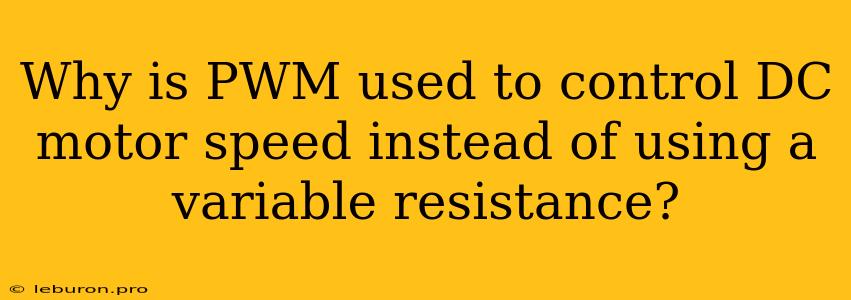Why is PWM Used to Control DC Motor Speed Instead of Using a Variable Resistance?
Controlling the speed of a DC motor is a fundamental requirement in many applications, from robotics and automation to consumer electronics. While variable resistance seems like a straightforward solution, Pulse Width Modulation (PWM) has become the preferred method for controlling DC motor speed. This is due to its superior efficiency, controllability, and heat dissipation characteristics compared to using a variable resistor. This article will delve into the reasons why PWM reigns supreme in controlling DC motor speed.
Understanding the Basics of DC Motor Speed Control
A DC motor's speed is directly proportional to the voltage applied across its terminals. This means that increasing the voltage will result in a faster rotation, and vice versa. Traditionally, a variable resistor was employed to control the voltage and, consequently, the speed. However, this method suffers from significant drawbacks.
The Drawbacks of Using a Variable Resistor
Inefficiency:
When a variable resistor is used to control the motor speed, a significant portion of the electrical energy is dissipated as heat within the resistor itself. This heat loss is due to the Joule heating effect, where energy is converted into heat when current flows through a resistance. This inefficiency leads to energy waste and can even damage the resistor.
Limited Controllability:
Using a variable resistor provides only a limited range of speed control. Fine-tuning the motor speed requires precise adjustments of the resistance, which can be difficult and time-consuming. Additionally, the speed control can be affected by variations in the supply voltage.
Heat Generation:
The significant heat generated by the resistor can pose a safety hazard and may require additional cooling mechanisms. This can add complexity and cost to the overall system.
The Rise of PWM for DC Motor Speed Control
PWM, or Pulse Width Modulation, is a technique that employs a series of on-off pulses to control the average voltage applied to the DC motor. By varying the duty cycle of these pulses – the ratio of the pulse's "on" time to its total period – the average voltage can be adjusted, effectively controlling the motor speed.
Advantages of Using PWM
Higher Efficiency:
PWM is a highly efficient method of motor speed control. Instead of dissipating energy as heat in a resistor, PWM utilizes the motor's internal resistance to regulate the power. This minimizes energy loss and increases the overall system efficiency.
Precise Controllability:
PWM offers a high level of precision in controlling the motor speed. By adjusting the duty cycle of the pulses, the motor speed can be finely tuned with high accuracy.
Reduced Heat Generation:
Since PWM minimizes energy dissipation, the system generates significantly less heat compared to using a variable resistor. This reduces the need for additional cooling mechanisms and improves the system's reliability.
Flexibility:
PWM controllers can be easily integrated with microcontrollers and other digital circuits, enabling complex control schemes and feedback loops for precise motor control.
How PWM Works
A PWM controller generates a series of rectangular pulses with a specific frequency and duty cycle. This signal is then applied to the DC motor. When the pulse is "on", the motor receives the full supply voltage, and when the pulse is "off", the motor receives no voltage. The average voltage applied to the motor is determined by the duty cycle. A higher duty cycle corresponds to a higher average voltage and faster motor speed.
Conclusion
PWM has emerged as the preferred method for controlling DC motor speed due to its efficiency, precise controllability, low heat generation, and flexibility. While variable resistors offer a simple approach, their drawbacks in terms of efficiency, controllability, and heat generation make them less suitable for most applications. PWM provides a superior alternative, enabling efficient, precise, and reliable DC motor speed control.
